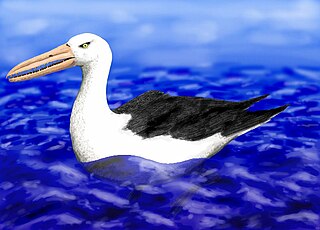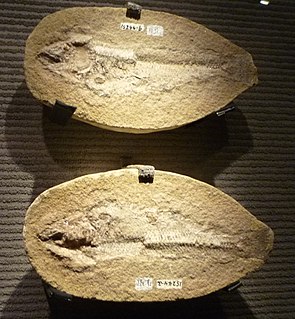
The Molidae comprise the family of the molas or ocean sunfishes, unusual fish whose bodies come to an end just behind the dorsal and anal fins, giving them a "half-fish" appearance. They are also the largest of the ray-finned bony fish, with the ocean sunfish Mola mola and southern sunfish, Mola alexandrini, both recorded at up to 4.6 m (15 ft) in length and 2,300 kg (5,100 lb) in weight.

Osteodontornis is an extinct seabird genus. It contains a single named species, Osteodontornis orri, which was described quite exactly one century after the first species of the Pelagornithidae was. O. orri was named after then-recently deceased naturalist Ellison Orr.
Hemipristis is a genus of weasel sharks, family Hemigaleidae. It contains one extant species, the snaggletooth shark and several extinct species.
Kentriodon is an extinct genus of toothed whale related to modern-day dolphins. Fossils have been found in Europe, Japan, Korea, and the Western Hemisphere. Seven species have been described so far.

Diplomystus is an extinct genus of freshwater clupeomorph fish distantly related to modern-day extant herrings, alewives, and sardines. The genus was first named and described by Edward Drinker Cope in 1877. There are seven species of Diplomystus: D. dentatus, D. birdii, D. dubetreiti, D. shengliensis, D. kokuraensis, D. primotinus, and D. altiformis.
La Venta is a fossil locality located in the modern departments of Tolima and Huila in Colombia. This site is one of the richest Neogene fossil assemblages in South America and represents the best-known Cenozoic fossil site outside of Argentina. It provides a glimpse of what life in the region was like before the main wave of the Great American Interchange.

Otodus angustidens is a species of prehistoric megatoothed sharks in the genus Otodus, which lived during the Oligocene and Miocene epochs about 33 to 22 million years ago. This shark is related to another extinct megatoothed shark, Otodus megalodon.
Paleontology or palaeontology is the study of prehistoric life forms on Earth through the examination of plant and animal fossils. This includes the study of body fossils, tracks (ichnites), burrows, cast-off parts, fossilised feces (coprolites), palynomorphs and chemical residues. Because humans have encountered fossils for millennia, paleontology has a long history both before and after becoming formalized as a science. This article records significant discoveries and events related to paleontology that occurred or were published in the year 1986.

Brygmophyseter, known as the biting sperm whale, is an extinct genus of toothed whale in the sperm whale family with one species, B. shigensis. When it was first described in 1994, the species was placed in the genus Scaldicetus based on tooth morphology, but this was later revised in 1995. In 2006, it was classified into the genus Naganocetus, which is considered to be a junior synonym. The only known specimen, a nearly complete skeleton, was dated to be around 14–15 million years old. Brygmophyseter is thought to have been 7 meters (23 ft) long, and it probably had 11 or 12 teeth in the upper and lower jaws. Brygmophyseter is part of a group of macroraptorial sperm whales which tended to be apex predators using their large teeth to catch struggling prey such as whales. It had a spermaceti organ which was probably used for biosonar like in the modern sperm whale. The whale has made an appearance on The History Channel's TV series Jurassic Fight Club.
Pseudodontornis is a rather disputed genus of the prehistoric pseudotooth birds. The pseudotooth birds or pelagornithids were probably rather close relatives of either pelicans and storks, or of waterfowl, and are here placed in the order Odontopterygiformes to account for this uncertainty. Up to five species are commonly recognized in this genus.

Tharrhias is an extinct genus of prehistoric bony fish that lived during the Aptian stage of the Early Cretaceous epoch. The type species T. araripis is named after the Araripe Basin, in which it was found in sediments of the Santana Formation.
Xyne is an extinct genus of prehistoric herring that lived during the Upper Miocene subepoch.

Bolbocara gyrinus is an extinct rattail that lived during the Upper Miocene subepoch of Southern California. It may be related to the extant genus Bathygadus.
Swenzia is an extinct genus of coelacanthid fish from the late Jurassic of France. It contains a single species, S. latimerae, which was originally described as Wenzia latimerae. Because the generic name Wenzia was already preoccupied by a snail, the generic name was amended to Swenzia. It is the fossil genus most closely related to the living coelacanth, Latimeria.
Protautoga is an extinct genus of prehistoric ray-finned fish, that lived in the Middle Miocene. Fossils have been found in the Paraná Formation of Argentina and the Calvert Formation of Virginia.
Aphaenogaster avita is an extinct species of ant in the subfamily Myrmicinae known from a solitary early to middle Miocene fossil found in Japan. At the time of description A. praerelicta was one of twelve Aphaenogaster species to have been described from fossils and the only fossil species from Japan.

Isurus planus, also known as the hooked-tooth mako shark or hooked mako shark, is an extinct lamnid that lived during the Miocene epoch from 23 to 5 million years ago. I. planus can only be found in marine deposits on the Pacific Rim, especially the west coast of the United States. Teeth belonging to I. planus can reach lengths of 2.0 in (5.0 cm), and are often found in the Temblor Formation of Bakersfield, California.

Cosmopolitodus is an extinct genus of sharks. Its only species is currently Cosmopolitodus hastalis, the broad-tooth mako. It is an extinct mackerel shark that lived between thirty to one million years ago during the Oligocene to the Early Pleistocene epochs. Its teeth can reach lengths up to 3.5 in (7.5 cm) and are found worldwide. It is believed to be an ancestor to the great white shark, a fact supported by the transitional species Carcharodon hubbelli, and most likely would have been one of the major predators in its ecosystem; preying upon small whales and other mammals.

Sinipercidae, the Chinese perches or Oriental perches, is a family of freshwater ray-finned fishes, part of the superfamiy Percoidea, suborder Percoidei of the order Perciformes.They have been placed within the temperate perch family, Percichthyidae in the past but may be more closely allied to the Centrarchidae.










